Symbols of sockets and switches on electrical diagrams

We have already talked many times about how important it is to correctly draw up a power supply scheme before carrying out repair work on a home electrician, everything should start with it. The diagrams show the main electrical units - an input line, an electric energy meter, protection devices, junction boxes and conductors outgoing from them, switching devices, lighting elements. In order to look at the diagram at least in the slightest degree to understand it, you need to know what the conventional designation of switches and sockets is in the drawings. We invite you to learn a little about this.
Many people begin repair work in a house under construction or a newly acquired apartment with the invitation of a specialist to help in drawing up a diagram. All you need to do is tell in detail where you plan to place large-sized furniture and household electrical appliances. And the task of a professional is to schematically display all this with an indication of the installation location of switches and sockets on the plan. Such a drawing will help you to clearly determine the amount of necessary materials and rationally plan the procedure for conducting electrical work.
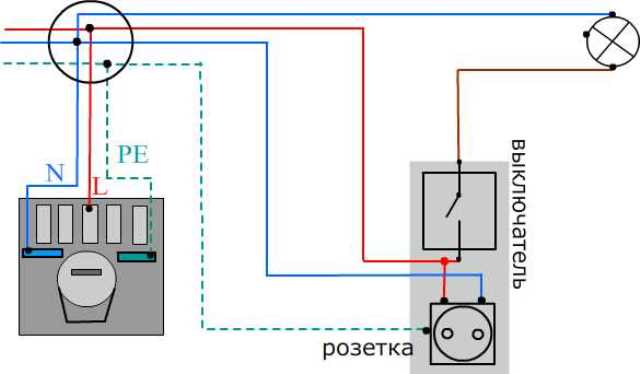
We will not talk about complex electrical elements, such as switches, relays, thyristors, triacs, motors. This is not necessary for household electrical systems. Our main task is to learn how to recognize the designation of household switches and sockets in schematic drawings.
The conventional designation of electrical elements is performed using graphic symbols - triangles, circles, rectangles, lines, etc.
Outlet designation
Socket - a switching device, which is part of the plug connection, works in tandem with a plug, is designed to connect electrical appliances to the network.
The designation of the sockets in the drawings is carried out in a semicircle, from the convex part of which one or more lines extend, depending on the type of switching device.
The video shows the main symbols of electrical equipment:
Sockets by the method of installation are:
- Outdoor (for open wiring). They are mounted on a wall surface. They are indicated by an empty semicircle that does not have any additional dashes inside.
- Internal (for hidden wiring). They are mounted inside the wall, for this you need to make a hole and insert a special socket into it, resembling a shallow glass in shape. In a schematic representation of such switching devices, a semicircle inside has a line in the center.
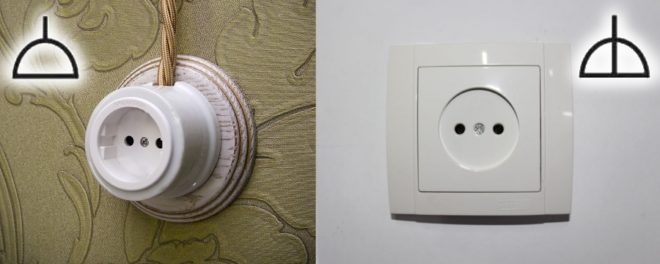
Double sockets are often used in household networks. They are a monoblock, in which there are two plug connectors (that is, you can connect two plugs from two different electrical appliances to them) and one mounting place (installation is done in one socket). The designation of a double socket on the electrical diagram looks like a semicircle with two dashes on the outer convex side:
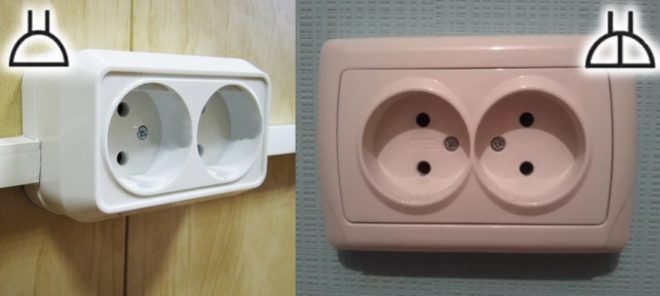
In modern household networks, grounded sockets are increasingly used; they guarantee long-term reliable operation of electrical appliances and the safety of people in terms of electric shock.
These devices differ from ordinary ones in that they have a third contact to which the ground wire is connected.
This wire goes to the general distribution board, where it is connected to a special ground terminal. The designation of such a socket on the electrical diagram is as follows:
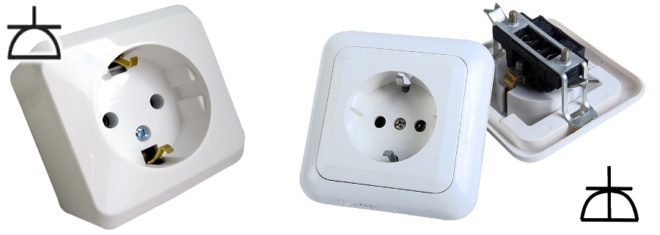
As you can see, grounding is indicated by a horizontal line, which is tangentially adjacent to the convex part of the semicircle.
It is no longer uncommon for a modern home to use not a single-phase electrical network, but a three-phase one.Some electricity consumers require exactly 380 V voltage (heating boilers, water heaters, electric stoves). For their connection, three-pole sockets with protective grounding are used. Switching devices of this type have five contacts - three phase, one zero and one more for protective grounding. A three-pole socket is indicated with three dashes on the outside of the semicircle:

And this is how the symbols for double sockets, with protective grounding look like:
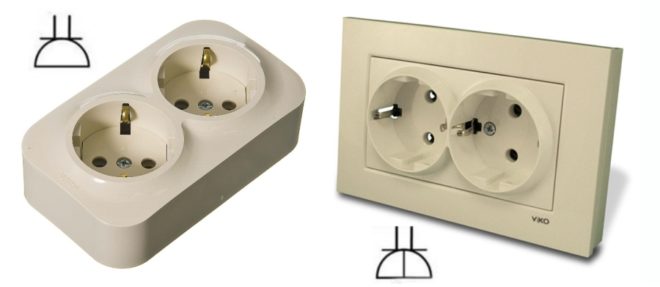
Sometimes you can see the designation of a socket, which has a semicircle inside completely painted over in black. This means that the switching device is moisture resistant, it is equipped with a protective cover, which excludes the possibility of moisture or dust getting into the outlet. The degree of protection of such elements is marked with special symbols:
- The two English letters IP denote the very concept that the socket has a certain level of protection.
- Then two numbers follow, the first of which indicates the degree of protection against dust, the second - against moisture.
In the diagram, sockets with a degree of protection IP 44-55 look like this:
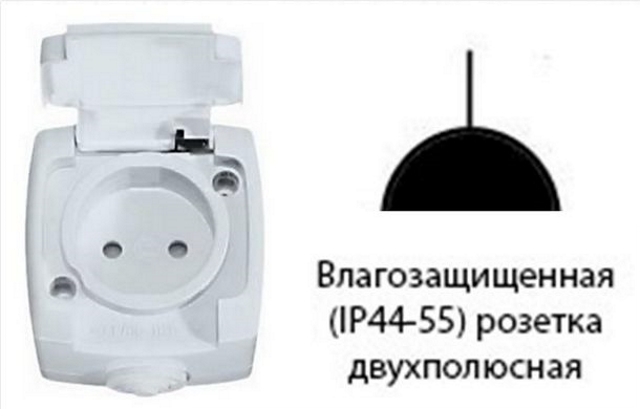
If they have a protective ground contact, then a horizontal line is added accordingly:

If you make a wiring diagram in specialized programs, then in the video an example of a drawing in AutoCad:
Switch designation
Switch - a switching device designed to control lighting devices in the house. During its on-off, the electrical circuit is closed or opened. Accordingly, when the switch is on, the voltage is supplied to the luminaire in a closed circuit, and it lights up. Conversely, if the switch is off, the electrical circuit is broken, the voltage does not reach the light bulb, and it does not light up.
The designation of switches in the drawings is performed by a circle with a dash at the top:

As you can see, the dash at the end still has a small hook. This means that the switching device is single-key. The designation of a two-button and three-button switches, respectively, will have two and three hooks:
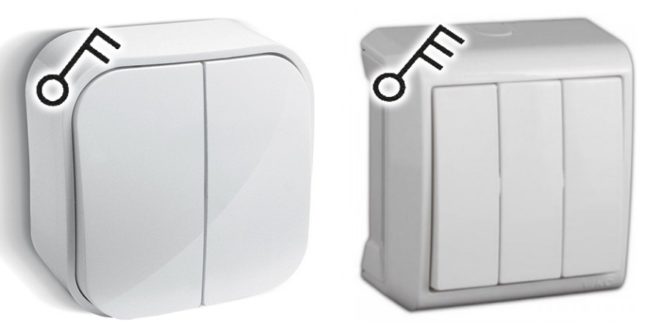
Like sockets, switches can be external and internal. All of the above designations refer to devices for open (or outdoor) installation, that is, when they are mounted on a wall surface.
A flush-mounted (or internal) switch in the diagram is indicated in the same way, only with hooks pointing in both directions:
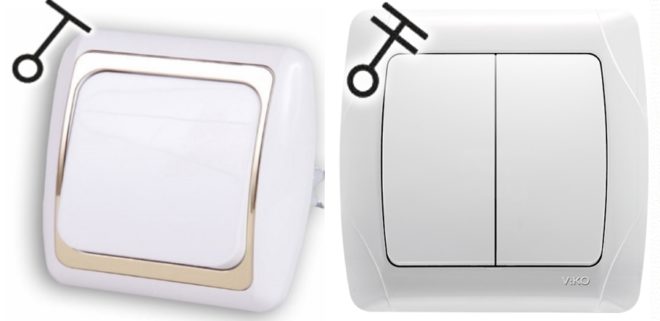
Switches designed for outdoor installation or in rooms with high humidity have a certain degree of protection, which is marked in the same way as for sockets - IP 44-55. In the diagrams, such switches are depicted with a circle filled with black inside:
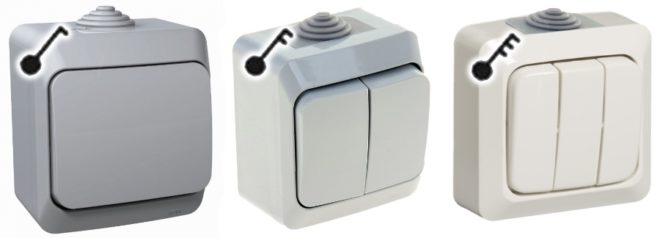
Sometimes you can see on the diagram an image of a switch, with lines with hooks pointing in two opposite directions from the circle, as if in a mirror image. Thus, a switch is designated or, as it is called in another way, a pass-through switch.
These switching devices are connected according to a special scheme and make it possible to control the same lighting device from different places (their use is very convenient in long corridors, on staircases).
They can also be two-key or three-key:
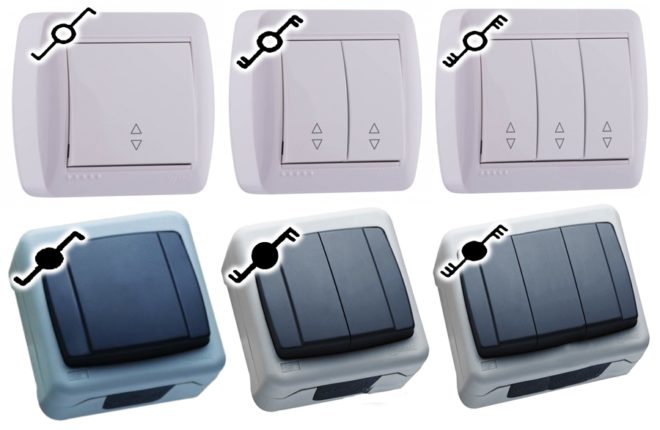
Block designation
Many probably had to deal with such an element of the electrical network as the switch-socket unit. Its use is very beneficial. First, it saves a little space. And secondly, there is no need to make grooves for laying wires separately to each switching device (the conductors going to both the outlet and the switch are laid in one strobe). These blocks are arranged in different ways.
Clearly about the blocks in the following video:
The designation of sockets and switches combined in one block looks much more complicated on the diagram:
- Flush-mounted unit with one switch and one socket.
- Flush-mounted unit with one switch and one socket with protective earthing.
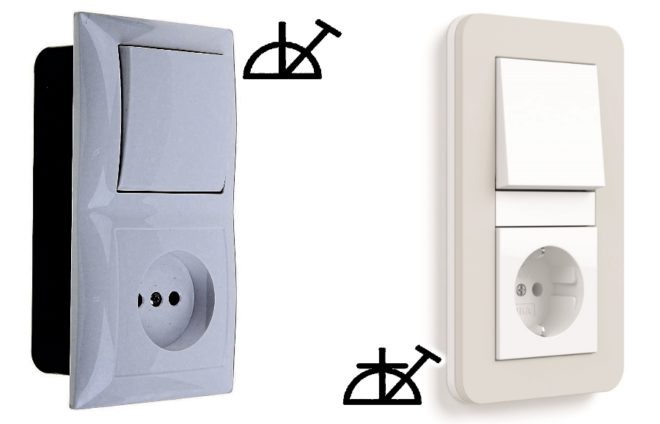
- Flush-mounted unit consisting of two switches and a socket with protective earthing.
- Flush-mounted unit consisting of a one-gang switch, a two-gang switch and a socket with protective earthing.
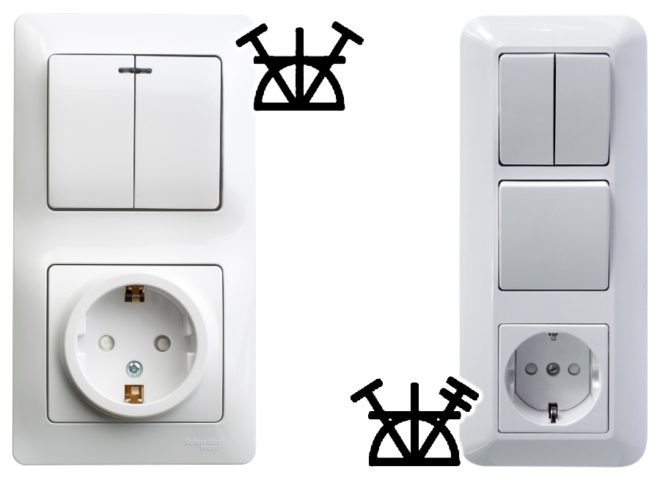
All these images do not need to be learned by heart, the main thing is to understand them. And a good, well-drawn up drawing should always have footnotes at the bottom with the decoding of certain designations.




